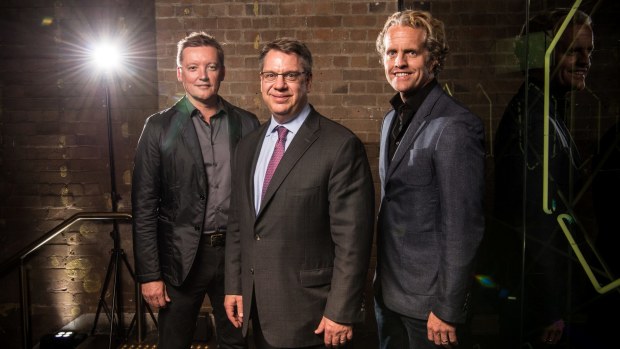BCG Digital Ventures shows corporates how to build new growth options

Boards need to set up the right incentives so that well-paid executive teams do not just "ride out disruption" without tackling it before their tenure ends, said Mike Schwartz, the managing director Australia of Boston Consulting Group's Digital Ventures group.
Schwartz said that he had met "a small handful of forward-thinking board members" who recognise they need to help bring their boards up to speed with the potential and threats of disruptive innovation.
"These are about to be pressing times," he said, at the launch of BCGDV's Sydney offices last week. Executives are well paid overall, he said, and it's the board's job to ensure executives deal with disruption threats and opportunities effectively. Often, he says, boards feel nervous about challenging executive teams on the topic.

Mike Schwartz, Rich Lesser and Jeff Schumacher from BCG Digital Ventures say they can solve the innovator's dilemma. Wolter Peeters
BCG chief executive and president Rich Lesser, who was in Australia for the launch of BCGDV's Sydney offices last week, said large companies "have struggled, particularly in digital" to find new growth. Lesser set up BCGDV in 2014, as a separate unit to be a corporate investment and incubation firm.
Jeff Schumacher, BCGDV founder and chief executive, said DV aims to solve 'the innovator's dilemma', referring to the problem, identified by Harvard Business School Professor Clayton Christensen, when large companies struggle with deploying disruptive technology because of concerns that it will undermine revenue streams from their core business.
"If legacy businesses leverage their core assets they can be disruptors, and that's where we are flipping the model – we are changing them into becoming attackers and disruptors in the market. We aim to be the translational layer between the corporates and start-ups."
Schumacher said $2 trillion was parked on corporate balance sheets at present that could be deployed to unleash innovation. Last year, corporate venture capital investment represented around 20 per cent of all invested capital in the US.
But he said many corporations were "fatigued" by disruption and have been cost-cutting in response rather than investing in growth options.
DV teams up with corporates to create a new product or service that has market value but which also brings a strategic value at the core of the business.
With offices in Los Angeles, Berlin, Shanghai, Sydney, San Francisco, New York and London, and with 450 staff, the BCGDV model means the group can put fees at risk for a period while it demonstrates its capabilities to the corporate partner and then be rewarded with sweat equity. It also invests its own capital or brings in associate venture firm B Capital.
BCGDV will focus on healthcare, transport, industrial, financial services and consumer services. The Australian office has built a digital banking platform - Advance - a service for companies that wish to challenge banks, or banks that need to bring their digital offering up to speed. It has also built AutoGravity, a new car financing platform.
Subscribe to gift this article
Gift 5 articles to anyone you choose each month when you subscribe.
Subscribe nowAlready a subscriber?
Introducing your Newsfeed
Follow the topics, people and companies that matter to you.
Find out moreRead More
Latest In Management
Fetching latest articles